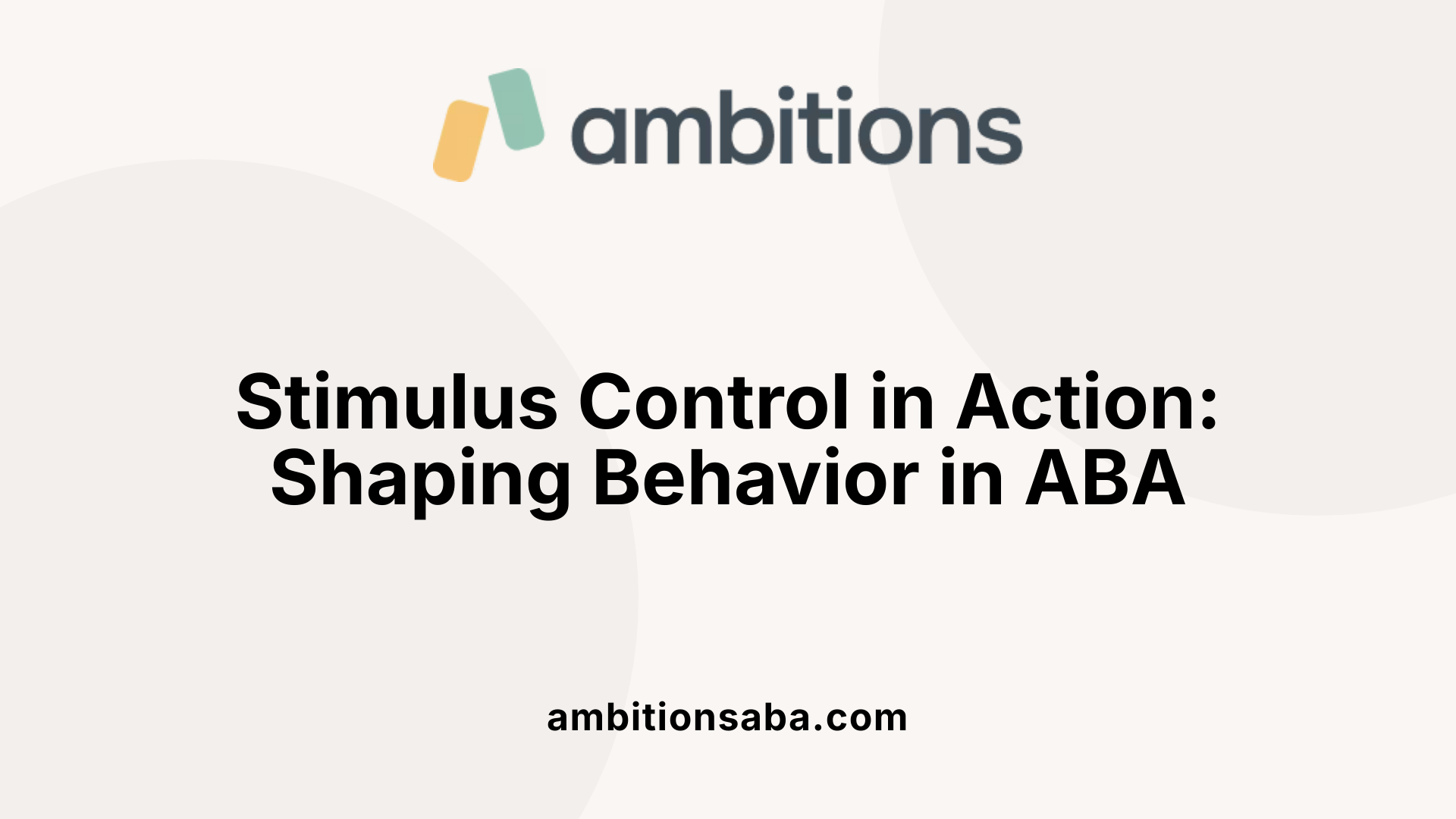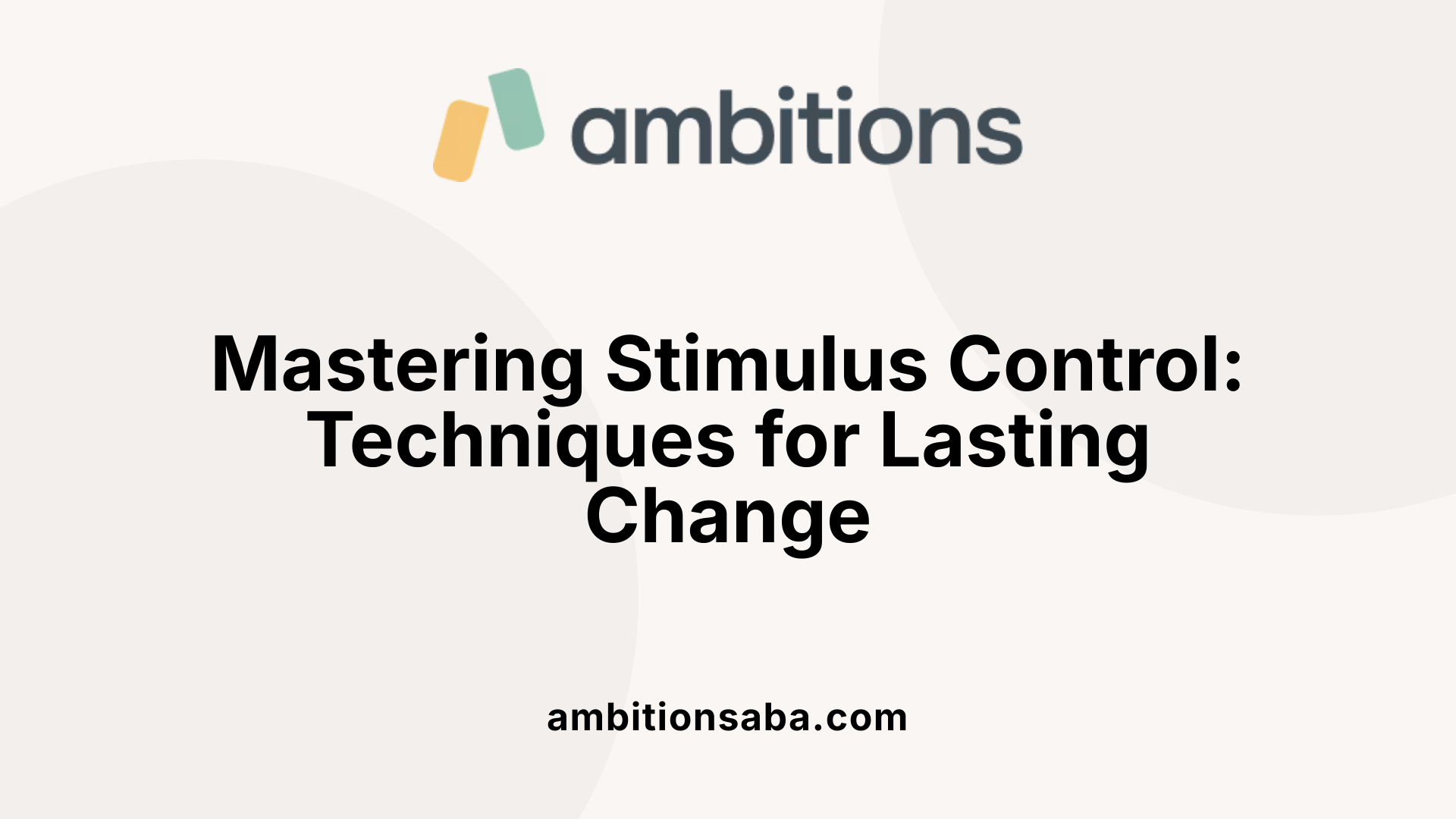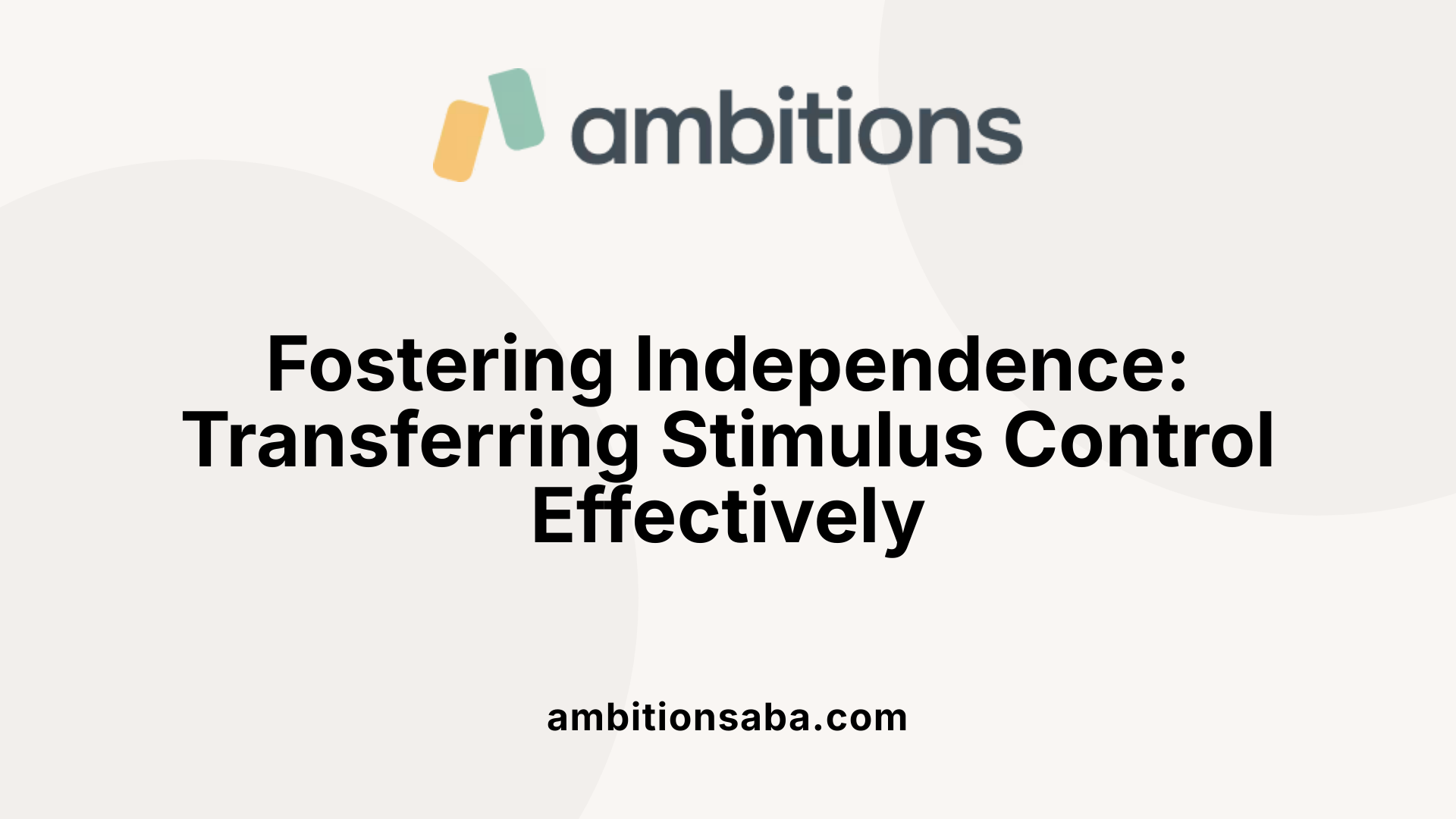Effective Strategies for Managing Scripted Speech in Children with Autism
An Introduction to Stimulus Control and ABA Therapy
Applied Behavior Analysis (ABA) therapy is a widely used, science-based approach designed to understand and modify behavior, particularly in children with autism. Central to ABA is the concept of stimulus control, which explains how certain environmental cues influence when and how behaviors occur. This article explores the role of stimulus control in ABA, how it facilitates learning and behavior change, and its critical function in teaching and generalizing skills for greater independence.
What is Applied Behavior Analysis (ABA) Therapy?
Definition of ABA therapy
Applied Behavior Analysis (ABA) therapy is a science-based, individualized treatment approach focused on understanding how behavior works and how it is influenced by the environment. ABA aims to increase helpful behaviors such as language, communication, social skills, and daily living skills while decreasing harmful or interfering behaviors. This therapy uses principles of learning and behavior to promote meaningful improvements.
Goals of ABA
The primary goal of ABA therapy is to develop functional, independent behaviors tailored to each individual’s needs. ABA programs often target communication, social interactions, self-care, play, motor skills, and academic achievement. By fostering these skills, ABA helps improve overall quality of life and supports long-term growth.
Techniques used in ABA
ABA employs various techniques to teach and reinforce positive behaviors. Key methods include positive reinforcement, prompting, prompt fading (gradually reducing prompts), shaping new behaviors, and errorless learning (minimizing mistakes). The therapy also uses the A-B-C model (Antecedent, Behavior, Consequence) to analyze and modify behaviors systematically.
Role of professionals in ABA therapy
Board Certified Behavior Analysts (BCBAs) oversee ABA programs, conducting detailed assessments to customize interventions based on the child’s strengths, preferences, and progress. These professionals ensure therapy is scientifically guided and adapted as necessary to maximize effectiveness.
Evidence for ABA effectiveness
ABA is an evidence-based practice widely supported by research, especially for children with autism spectrum disorder. Intensive and long-term ABA treatment has demonstrated improvements in language, cognitive skills, adaptive behaviors, and social communication across diverse settings. Insurance often covers ABA when medically necessary, reflecting its recognized value.
How ABA Therapy Supports Individuals with Autism

ABA’s Impact on Skill Development
Applied Behavior Analysis (ABA) therapy is a well-established approach that helps individuals with autism by focusing on the science of learning and behavior. It supports the development of essential skills such as language, communication, social interaction, self-care, and academic abilities. Through targeted teaching methods, ABA promotes both new skill acquisition and the strengthening of existing behaviors.
Use of Positive Reinforcement
A central component of ABA is positive reinforcement, which involves providing a valued reward immediately following a desired behavior. This strategy increases the likelihood that the behavior will occur again. For example, reinforcing a child when they respond correctly to a prompt encourages continued engagement and learning.
Techniques for Behavior Improvement
ABA employs various techniques including prompting and prompt fading, shaping, and errorless learning to effectively teach and generalize behaviors. These methods help transfer control to natural cues, promoting independence. For instance, prompt fading gradually reduces support until the behavior occurs in response to natural stimuli, such as a child learning to wash their hands when seeing the sink instead of requiring verbal prompts.
Individualized Interventions
Each ABA program is customized to the individual's needs and preferences. Qualified behavior analysts (BCBAs) conduct thorough assessments to develop goals that may include communication, social skills, or daily living activities. These personalized plans ensure the therapy fits the unique requirements of each child.
Research-Backed Outcomes
Decades of research confirm ABA as an evidence-based practice, especially effective in improving outcomes for children with autism. Early and intensive interventions focusing on behavior transfer and generalization have shown significant gains in language, cognitive abilities, and adaptive behavior, helping children participate more fully in their communities.
The Role of Stimulus Control in ABA Therapy

What is Stimulus Control in ABA Therapy?
Stimulus control in Applied Behavior Analysis (ABA) explains how certain behaviors are triggered by specific cues or stimuli in the environment. Essentially, a behavior is more likely to happen when a particular stimulus is present and less likely when it is absent.
How Do Specific Stimuli Influence Behavior?
In ABA, the presence of specific stimuli can prompt behaviors through a concept called discriminative stimuli (SD). These cues signal that a behavior will be reinforced if performed, thereby encouraging the individual to respond appropriately. Conversely, stimulus delta (SΔ) signals when reinforcement for a behavior is unavailable, helping the learner understand when a behavior is not expected.
What are Discriminative Stimuli (SD) and Stimulus Delta (SΔ)?
- Discriminative Stimuli (SD): These are signals or cues that indicate a behavior will be rewarded or reinforced if performed.
- Stimulus Delta (SΔ): These are cues that indicate a behavior will not be reinforced in that situation. This distinction helps individuals learn when and where certain behaviors are appropriate.
How Is Stimulus Control Applied in Teaching and Behavior Modification?
ABA therapists use stimulus control to teach new skills by associating behaviors with particular cues. Techniques such as prompting, prompt fading, shaping, and reinforcement help transfer behavior control from artificial prompts to natural stimuli. This ensures behaviors occur independently and appropriately in everyday situations.
Examples of Stimulus Control in Daily Life
- A child learning to raise their hand when a teacher asks a question.
- Responding to a stop sign while driving.
- Using daily visual schedules or timers to manage activities.
- Teaching social greetings triggered by seeing a peer.
By linking behaviors to consistent and clear stimuli, stimulus control plays a vital role in fostering independent and functional skills in ABA therapy.
Techniques to Establish and Transfer Stimulus Control

What techniques are commonly used in ABA therapy?
ABA therapy employs several well-established techniques to shape and transfer stimulus control effectively. These methods promote independence and help children respond appropriately to natural cues in their environment.
Prompting and prompt fading methods
Prompting involves providing assistance or cues to encourage the desired behavior. Common prompt fading strategies include:
- Most-to-least prompting: Starting with the most supportive prompt and gradually reducing assistance.
- Least-to-most prompting: Beginning with minimal help and increasing prompts only if necessary.
By gradually reducing prompt dependence, learners gain independence as control shifts from artificial cues to natural stimuli.
Shaping and reinforcement
Shaping breaks down complex behaviors into smaller steps, reinforcing successive approximations until the target behavior is achieved. Positive reinforcement—a key ABA strategy—increases the likelihood of desired behaviors by rewarding correct responses.
Errorless learning
This technique minimizes mistakes by carefully structuring teaching sessions so the learner is less likely to emit incorrect responses. Errorless learning supports faster acquisition and reduces frustration.
Discrimination training
Discrimination training teaches individuals to respond differently to various stimuli, reinforcing behaviors only in the presence of specific cues (discriminative stimuli or SD) while ignoring others (stimulus delta or SΔ). This process strengthens appropriate stimulus control.
Stimulus fading and transfer procedures
Stimulus fading gradually changes or reduces the original stimulus controlling the behavior, while transfer procedures involve introducing new stimuli that will eventually guide the behavior independently. For example, teaching a child to request an item initially with a picture card prompt and then fading the card to rely on the natural presence of the object.
Together, these techniques enable effective stimulus control transfer in a systematic way, supporting skill acquisition, generalization, and maintenance across settings. The goal is that behaviors become naturally cued and maintained without reliance on artificial prompts or supports.
Stimulus Control Transfer: Fostering Independence and Generalization

What Is the Process of Transferring Stimulus Control?
Stimulus control transfer in Applied Behavior Analysis (ABA) involves gradually shifting the control of a behavior from an artificial prompt or cue to a natural, everyday stimulus. Initially, a prompt (such as a verbal cue, gesture, or physical guidance) helps the individual perform the desired behavior. Over time, this prompt is systematically faded out so that the individual learns to respond reliably to the natural stimulus alone. This transfer process typically includes identifying the target behavior, teaching it with the original prompt, introducing the new natural stimulus, and reinforcing the behavior until independence is achieved.
Why Is Fading Artificial Prompts Important?
Fading artificial prompts is crucial because it promotes independence and reduces reliance on external assistance. When prompts are not faded properly, the individual may only perform the behavior in the presence of the prompt, limiting the behavior’s usefulness in real-life situations. Techniques used for fading include most-to-least prompting, least-to-most prompting, shaping, and errorless learning, all designed to ensure smooth and successful transitions.
How Does Stimulus Control Transfer Support Generalization?
Generalization means applying learned behaviors across different settings, stimuli, and situations. Stimulus control transfer supports this by using strategies such as training in varied environments, involving multiple stimuli, and employing diverse reinforcement schedules. For example, a child might learn to say "hello" in therapy sessions and then generalize this greeting in school, at home, and in the community. This broadens the behavior's functional value and helps maintain it over time.
How Is Stimulus Control Used to Reduce Maladaptive Behaviors?
Stimulus control transfer can also replace maladaptive or problem behaviors by shifting stimulus control toward appropriate, positive responses. For instance, a child might be taught to request a break when overwhelmed instead of engaging in disruptive behaviors. By associating these positive behaviors with natural cues and fading prompts, children gain more effective and socially acceptable ways to communicate and cope.
What Are Examples in Everyday Skills and Social Interactions?
Stimulus control transfer is widely used in teaching academic skills, social communication, and daily living routines. Examples include teaching a child to raise their hand when a teacher signals, requesting a drink by recognizing a cup, and independently performing handwashing by responding to environmental visual cues. These transfers help children with autism and other developmental challenges respond appropriately in various real-world contexts, increasing their confidence and autonomy.
Measuring Progress and Overcoming Challenges in Stimulus Control
How are data collection methods used to measure progress in stimulus control?
ABA therapy relies on precise data collection to track behavioral changes during stimulus control procedures. Common methods include frequency counts, which tally how often a behavior occurs; duration measures, recording how long behaviors persist; and ABC data that documents the Antecedent, Behavior, and Consequence sequence to understand triggers and outcomes. These approaches provide quantitative and contextual information essential for monitoring skill acquisition and identifying areas needing adjustment.
How is assessment of generalization and maintenance conducted?
To ensure learned behaviors transfer beyond clinical settings, therapists regularly probe generalization by presenting skills across varied environments and stimuli. Maintenance assessment involves checking if behaviors sustain over time without continuous prompts. This often includes using checklists and testing behaviors in natural contexts, engaging caregivers, and evaluating if responses remain consistent, which is crucial for functional independence.
What challenges arise in achieving generalization during stimulus control transfer?
Generalizing behaviors to new settings can be difficult due to over-reliance on specific cues, limited exposure to diverse environments, or inconsistent reinforcement. Children might respond correctly only in therapy sessions but not in everyday life, increasing frustration and limiting progress.
Why are personalized approaches and therapy continuity important?
Stimulus control methods must be tailored to each individual’s preferences and learning pace to overcome variability in responses. Consistent therapy delivery, even amid external disruptions, ensures steady skill development and reduces regression risks. Inclusion of caregivers supports naturalistic practice and reinforces learning outside therapy.
How can prompt dependency and inconsistent implementation be addressed?
Prompt fading techniques—such as moving from most-to-least intrusive prompts—help reduce reliance on artificial cues, encouraging responses to natural stimuli. Clear protocols and staff training promote consistent intervention application, while ongoing monitoring prevents prompt overuse and supports smooth transfer of behavioral control.
| Data Collection Method | Purpose | Application Example |
|---|---|---|
| Frequency Counts | Measures how often a behavior occurs | Counting hand raises during class |
| Duration Measures | Records behavior length | Timing attention spans during tasks |
| ABC Data | Examines antecedents and consequences | Identifying triggers for tantrums |
| Generalization Checks | Tests behavior across settings | Observing greeting skills at home and school |
| Maintenance Probes | Evaluates skill persistence over time | Ensuring continued handwashing after treatment |
These systematic assessment and adaptation strategies are vital in overcoming practical hurdles to effective stimulus control and maximizing ABA therapy outcomes.
The Role of Professionals and Families in Stimulus Control

Who provides ABA therapy services?
ABA therapy is delivered by a team of skilled professionals. Board Certified Behavior Analysts (BCBAs) design and oversee individualized programs based on thorough assessments. Registered Behavior Technicians (RBTs) and ABA therapists provide direct intervention, working with clients in settings like homes, schools, and clinics. Specialized organizations often coordinate these services.
Involvement of BCBAs, RBTs, and therapists
BCBAs supervise and customize treatment plans, ensuring that stimulus control techniques—such as prompting and reinforcement—are applied effectively. RBTs and therapists implement these plans daily, using strategies like prompt fading and errorless learning. This collaborative approach ensures consistent and evidence-based interventions.
Parental and caregiver participation
Parents and caregivers play a vital role by reinforcing learned behaviors in natural environments. Training families to recognize discriminative stimuli and apply consistent cues helps maintain skill gains. Their involvement encourages generalization of behaviors across settings like home and community.
Customization of programs
ABA programs are tailored to individual needs, focusing on specific goals such as communication, social skills, or daily living tasks. Professionals adjust strategies based on progress data and client preferences, which supports successful stimulus control transfer.
Supporting skill generalization and maintenance at home
Families support generalization by practicing skills in varied environments and continuing reinforcement outside of therapy sessions. Strategies like using visual aids, consistent prompting, and involvement in daily routines help solidify independent and natural behaviors learned during therapy.
Effectiveness and Limitations of ABA and Stimulus Control Approaches
Is ABA therapy effective for all individuals with autism?
Applied Behavior Analysis (ABA) is an evidence-based intervention widely used to support children with autism spectrum disorder (ASD). Research has consistently shown that early and intensive ABA programs, typically involving 10 to 20 hours per week, can significantly improve social communication, language, cognitive skills, and reduce challenging behaviors. The use of stimulus control principles within ABA supports these improvements by helping children respond to natural cues independently and generalize skills across environments.
Early and Intensive Intervention
The greatest gains with ABA are often seen when therapy is started early in life and delivered intensively. Early behavioral interventions grounded in stimulus control transfer have been shown to cultivate language, adaptive behaviors, and social interactions more effectively. Prompt fading, reinforcement schedules, and varied training settings play crucial roles in maintaining and generalizing behaviors beyond clinical settings.
Limitations and Criticisms
Despite its proven benefits, ABA is not universally effective for every individual and has faced criticisms. Some argue that ABA can be repetitive or overly focused on conformity, potentially overlooking the individual's preferences and neurodiversity. Concerns include the risk of suppressing natural behaviors that are meaningful to the child and inadvertently causing distress.
Importance of Tailoring Therapy to Individual Needs
Addressing these limitations requires customizing ABA programs to each person’s unique skills, interests, and needs. Qualified behavior analysts (BCBAs) assess and design interventions that promote autonomy, positive reinforcement, and joyful engagement. Parental involvement and consistent reinforcement across environments further enhance outcomes and support meaningful skill acquisition.
Balancing Structure with Respect for Neurodiversity
An effective approach balances ABA’s structured methods with respect for neurodiversity by promoting functional, independent learning without forcing conformity. Stimulus control techniques are used thoughtfully to encourage appropriate behaviors while honoring the individuality of each child, ultimately striving for well-being and improved quality of life.
| Factor | Description | Impact on ABA Effectiveness |
|---|---|---|
| Early Intervention | Starting ABA at a young age with sufficient hours | Leads to more substantial and sustained skill gains |
| Intensity | Number of weekly therapy hours | Higher intensity correlates with better outcomes |
| Individualization | Customized goals and teaching strategies | Addresses unique needs and preferences, improving engagement |
| Parental Involvement | Family participation in teaching and reinforcement | Enhances generalization and maintenance of learned behaviors |
| Neurodiversity Considerations | Respecting the child’s identity and natural behaviors | Ensures therapy supports autonomy and reduces distress |
This balanced perspective highlights that while ABA and stimulus control are powerful tools in behavioral therapy, their success depends heavily on thoughtful, personalized application and ongoing adjustment to each individual's context.
Stimulus Control as a Cornerstone of Effective ABA Therapy
Stimulus control is fundamental to the success of ABA therapy, serving as the mechanism through which behaviors are linked to specific cues in the environment. By systematically teaching individuals to respond to appropriate discriminative stimuli and transferring control away from prompts or artificial aids, ABA promotes independence, adaptability, and skill generalization. While challenges exist in ensuring behavior transfers across different settings and stimuli, careful assessment, individualized planning, and collaboration between professionals and families help overcome these obstacles. Understanding stimulus control deepens appreciation of how ABA therapies work to enhance lives, particularly for children with autism, fostering meaningful and lasting behavioral improvements.
References
- Stimulus Control Transfer in ABA Therapy: When to Use & ...
- Applied Behavior Analysis (ABA)
- How Stimulus Control Helps Shape Positive Behaviors in ...
- Exploring the Benefits of Stimulus Control Transfer in ABA ...
- What is Stimulus Control in ABA: Definition & Examples
- Understanding Stimulus Control Transfer in ABA Therapy
- The effectiveness of applied behavior analysis program ...
- The Controversy Around ABA
- Efficacy of Interventions Based on Applied Behavior ...
- 6 Benefits of ABA Therapy for Children with Autism

